
Wittie - The Smart Apartment.
School project @ University of Washington | 9 weeks | 2017
Wittie is a mobile application that supports users to adopt healthy energy-saving behaviors by connecting every device together even they were not built that way in order to provide the full control and information for the user. Moreover, with the gamification strategy, the users are incentivized to choose green lifestyles by reducing energy consumption. This helps people achieve a better energy saving habits and also potentially reduce more than 2,500 tons of carbon emissions every day.
Tool Used: Sketch, Illustrator, Invision, Principle, Photoshop, Pen and paper, Human brain
My Role: I was a part of a small team with another researcher and responsible for the experience strategy and the design of the iOS app. I lead the UX work, producing all the deliverables and presenting them to the class.
Everyone participated throughout the research process until we arrived at our ideation phase. During the research phase, I took charge in creating the storyboards. After that, I came up with the wireframes and the user flow for the virtual pet concept which ended up as our final solution. Furthermore, I created the high fidelity designs for the mobile application using Sketch. Also with Invision, I created an interactive prototype of the application.
Challenge.
How might we create a system to improve energy conservation habits among people?
We find out that the United States could reduce overall greenhouse gas emissions by 7% if households adopted simple and money-saving efficiency actions. Hence, our solution focuses on a way to use technology to improve energy conservation behaviors by a city’s residents so as a whole, the city will reduce consumption and reduce its CO2 emissions.
Discovery.
Our research revealed that the concept of 'energy saving' represented differently in people's knowledge. Most of people states they would like to save energy but they don't know how to. "Does turn off lights save energy?" “How much hurt can leaving them on all day?”

52.9% of respondents aren’t aware that reducing consumption is a way of saving energy

65% of the respondents agreed that they would be more motivated to save electricity if they knew how much it costs to use an appliance
Survey from Singapore’s Ministry of Environment and Water Resources (2013)
Insight: We find out that people both lack information and awareness to save energy even though they want to.
Scholarly Research.
Research shows that the best incentive to have people adopt energy conservation habits and environmentally conscious behavior is altruism.
The results are intriguing. Households who received the air pollution message reduced their electrical consumption by 8.2% over the 100-d experimental monitoring period. Those in this group who had children changed their behavior even more dramatically, achieving a 19% reduction in consumption. In contrast, the households that received the monetary messages actually increased their consumption, and that increase was greater for households with children

Percentage of Reduction in Energy Consumption
Insight: Altruism and competition both serve better as an incentive for its users to adopt energy conservation habits than money.
Ideation.
Then it came to the fun part, we started to generate as many ideas as possible. I sketched them out in order to find flaws in the logic/ flow. Based on discussions and feedback from other people, we narrow down to the main two concepts. Competition door and connecting everything together.
Storyboard.
In order to better understand how this potential solution could help the user, we mapped out a specific day. The user just moved into a new apartment which has smart outlets are connected via wifi to the Wittie application, which the front desk has told him he can use to monitor his energy usage and do various activities to improve his energy conservation habits.


Prototyping and Testing.
With multiple feedback sessions and many more rounds of discussion, we yet again combined the strongest ideas from each concept in order to articulate a single idea into a testable prototype. .
PAPER PROTOTYPING

The device registration page was not clear to all users.
The first page of the flow where the user is shown an apartment layout with the locations of the outlets was unclear since 3 people were confused on what to do.
"Am I supposed to tap on an X, which is a power outlet right? I am not sure."
People tend to ignore notifications.
4 out of 6 people tapped ignore when given the option on our push notification that told them they left their lights on.
"I feel that these notifications might become a nuisance. Especially if you want to leave the lights on."
People like the idea of “competing with neighbors.”
“Am I more energy conscious than my neighbors. I am curious to find out.”
CLICK-THOUGH PROTOTYPE
For our second round of prototype evaluations, we tested a click-through, low-fidelity prototype with five participants. The goal of the testing sessions was evaluative rather than generative. Sessions were focused on assessing task completion, with follow-up questions around the difficulty of the tasks and any thoughts around moments of confusion or mismatched expectations.

Users were confusing by the slightly different design of bill and home
The layout of Home and Bill both have the similar design of container boxes, yet provide different information of Temperature and money. Some users hesitate to clearly scan what's in the box, and then click on them.
Plug-in triggered Registration is convenient and intuitive.
All the participates like how easy the onboarding registration with the plugin then manually input registration
"It saved a lot of time, especially consider moving in is a stressful and tired process."
Virtual Pet serves as a strong incentive
All the participates like how easy the onboarding registration with the plugin then manually input registration
Site Map

Introduce Wittie.
Wittie motivates people to adopt healthy energy-saving behaviors by providing enough information, monitoring and gamification strategy.
Wittie is part of a co-op between the energy company and apartment complexes to start out with and in the future broadening by allowing people to simply hookup smart outlets or devices that they buy into the app.
01
02
03
Allowing users to connect any device to the Smart Apartment environment and registering their connected devices through an onboarding system.
Gamifying the process of changing habits by providing residents with challenges and goals to improve conservation habits and see how others are doing compared to themselves
Providing information and valuable tips that educate users on benefits that adopting energy conservation behavior have.

Onboarding.
No need to have smart devices, the user simply plugs in the personal device to the wall. There would be a notification showing on their phone to guide them register the device.

02 Take Tea Kettle to the Kitchen
03 Plug in the kitchen area
04 Get a notification on the phone to register new device!
01 Want to register a tea kettle
Registration.
Wanting to make tea, John plugs in his new tea kettle, and a notification is sent to his phone from the application, asking if he would like to register his device.
Once he’s on the registration page he sees the recommended names to use based on where he plugged his device in, which is the kitchen but opts to simply type in the name himself.
Once he’s done, he presses go and is taken to the kitchen page where he sees that the "Tea Kettle" is now listed at the bottom of a page with a “New” icon next to it.



Besides registering by plugging the devices, the user can also manually register. Swiping to the right to "layout", the room layout map helps the user locate each outlet.
Application Monitoring.
The user was able to view all the appliances found in his room. By clicking on each appliance, The user was taken to a screen that gives them a further breakdown of how much energy each appliance uses. As they're doing this, he sees he’s been leaving his ceilings lights on a lot and makes a mental note to start turning off, starting now. Once summer came about, John knew that he would be using A/C more often, so he wants to know what temperature he should use to save energy.

By providing information and tips about the applications, the users will be educated and given feedback on how to improve energy
conservation behaviors. It provides the users with a sense of self-efficacy.

Wittie, the character.
Wittie is a plant that loves it when you take steps to conserve energy and reduce your carbon footprint.
This is because too much CO2 reduces the amount of organic compounds (water, soil) which he needs as nutrition to live Not to mention, if there’s too much CO2 in the atmosphere it will get too hot for Wittie to survive, as well as us. So, by reducing the amount of CO2 you produce, the more organic compounds there will be for Wittie.


Reduce Carbon Footprint

There are different levels of Wittie, the more tasks that the user completes, the larger and happier the Wittie will grow!

The user feels kind of bad that his Wittie is not doing great. This motivates him to want to complete more tasks.
He then finds out that is a button called "Global view". He now can see how's all his neighbors are doing. He finds out that some of their plants are already growing into a large tree. He feels a little competitive.



Challenge.
Not only provide the competitiveness, the Wittie Challenge feature gives the user the sense of achievement. By visualizing the plants as well as the forest, the users can have a more clear sense of what they can achieve when they only need to adopted simple and money-saving efficiency actions.
Moreover, the Challenge text on top to get to the list of tasks that tells them how to make Wittie grows larger.
The users can compete against each other in the Off peak hero challenge, which, if he completes it, will reduce his Carbon Footprint by 20g.
All of our carbon footprint numbers are based on what the average American would produce.


Building the whole forest.

He then realizes how much they can achieve together as a whole, to save the environment of Earth.

Reflections.

Keep balance between time, scope and resource
Given that our group only had 9 weeks to complete the whole project, we have made a lot of assumptions and made decisions based on casual interviews and secondary research. Also, for the high fidelity app, we didn't do usability testing. Instead, we use heuristic evaluation by our designer friends.
Documentation and specifications are important for communication
Even though we don't have a chance to implement the actual design, we still deliver the specifications as a practice. We find out that putting specs together does help a lot when we try to describe our design to someone else especially when their background isn't from design.
Next Steps
We know there are many more ways to refine and expand the scope of our product down the road. One next step my team would like to pursue is to seek the experts on the creation of content for the "challenge". If time permits, we would like to define tasks, establish objectives and evaluate the app.
